"Life is
greater than all art. I would go even further and declare that the man
whose life comes nearest to perfection is the greatest artist; for what
is art without the same foundation and framework of a noble life?" said
Gandhi.
I can't agree more
with Gandhi. However, when you look at many modern arts, you sense
insane minds and unhealthy anxiety rather than a noble life. Theologian
Paul Tillich suggested that since modern arts strongly reveal
overwhelming anxiety of modern people, modern arts could be analyzed in
the perspectives of deep psychology, existential philosophy and
theology. However, I think that it would be problematic if the values
of art rely on psychological, philosophical or theological analyses.
This approach provides an opportunity for artists and art critics to
glorify strange-looking arts by citing jargon. A few years ago I
visited a museum in Dallas, Texas, in which paintings of Marco Arce
were displayed. One caption stated that the painting reveals "clinical,
almost anthropological distance." What is "clinical and almost
anthropological distance?" Could I still appreciate arts without going
through this kind of "deep thoughts?"
Use
Common Sense
Thomas
Paine wrote the book entitled Common Sense to
illustrate the plain truth of democracy. I believe that there exists an
innate framework of common sense in human perception and reasoning. I
doubt whether it is proper for arts to go against our common sense and
our eyes, no matter what complicated theory and technical terms stand
behind them. I treat photography as an art of common sense. It means
that you can simply use your eyes to appreciate arts, just like that I
use my eyes to make it. No political, psychological, philosophical, or
theological backgrounds are required.
Thinking
and feeling
As
both a writer and photographer, I feel the tension between writing--the
art of mind, and photography--the art of eyes.
The preceding statement, of course, may be an over-generalization. I
don't mean that a photographer is mindless. What I am trying to point
out is: Message is the soul of writing, while medium is the main thread
of photography.
To
be specific, before I write an article, I should determine the theme
and then try to discover certain insights regarding that topic. I pay
less attention to wording and rhetoric because I realize that beautiful
language cannot save an essay if the content is poor. On the other
hand, when I plan to take a picture, my approach is exactly opposite to
that of writing. After I have found a subject, I devote efforts to make
the subject look interesting by experimenting with various lenses,
filters, and angles. After the picture has been taken, I give the photo
a title based upon how it looks. In short, vision precedes
meaning and medium precedes message.
Figure
1 is a photo that I took in Grand Teton National Park a year ago. No
doubt the cross seems to carry a strong religious connotation. However,
did I intent to make a religious implication from this picture? No, it
just happened that there was a cross in a chapel inside the National
Park. By chance, from a particular viewpoint the cross was situated
between two mountains. I captured this view just because it is visually
appealing.
Figure
1.
View of the mountains from a chapel
inside Grand Teton National Park
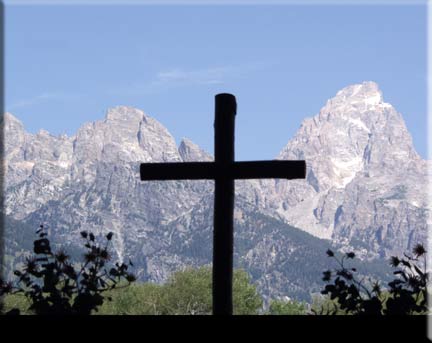
Figure
2 is another picture that is mistaken as being religious and
theological in essence, for the title of this picture is "Heavenly
Symbol." Someone asked me whether the picture was taken in a church and
the three lights symbolize the Holy Father, Holy Son, and Holy Ghost.
Behind the "cross" there is an open dome. Again, some viewers asked me
if it is a symbol of the heaven. I am almost embarrassed to tell you
that it is a view of the ceiling of a university's student service
center. One day I looked up the ceiling and was fascinated by this
spectacular view. At that moment my mind was occupied by the aesthetics
of the composition and the lighting. I did not think about Trinity or
any other religious themes at all. In other words, the title with a
religious meaning is an after-thought.
Figure
2.
"Heavenly Symbol" -- the ceiling of a
university's student service center.
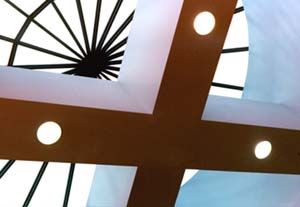
While
in La Jolla, CA for a conference last year, I had the opportunity to
take several pictures of birds near the shore. As you see in Figure 3,
a white bird stood on the top of a rock while many black ones were
below the white bird. I named the picture "Black and White." In
response to my naming, some viewers asked me whether I tried to make a
statement of social protest against racial inequalities. To be honest
with you, there are no social, political or philosophical meanings in
this photo. I cannot speak “bird language?and therefore I am not
capable of asking those birds to pose for this photo.
Figure
3.
"Black and White" -- a white bird
stands on top of a rock while many
black ones are below.
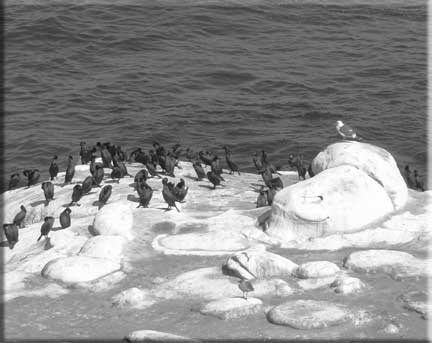
As
Don Sheff, director of New York Institute of Photography said, it is
impossible for a photographer to shoot pictures with philosophical
concepts such as "a universal theme"; what he needs to know in advance
is simply the subject matter. Prominent photographer Pete Turner also
conceded that many of his works are nothing more than "an eye-catcher"
and "a display of color," and "there is no deep meaning behind it".
Psychologist Carl Jung went even further to claim that thinking and
feeling are mutually exclusive. As a photographer, at the very moment
of creating art, I have intensive feelings resulting from the visual
impact. But when I start to analyze the subject, the intensity of the
feelings is affected.
Medium
and Message
Mass
communication scholar Marshall MacLuhan asserted that the
medium is the message, in the sense that the form always
determines the content. For example, British writer Roy Bomax said that
short stories should appeal to readers' emotions instead of intellect.
Appealing to intellect is more properly used in a Master's thesis or a
Doctoral dissertation. By the same principle, the medium of photography
is visual, and therefore logically the message should appeal to a form
of instant visual effect, referred to as "hot thinking" by MacLuhan. On
the other hand, the medium of writing uses linguistic symbols that
require decoding by a slow analytical process, refereed to as "cold
thinking".
Intuition
and Spilt-second Decision
The
above notion may not be new to you if you trace back the concept of
"pure painting" in art history. The so-called “pure painting?is an art
form stressing the visual elements rather than the motif. Nevertheless,
there is a difference between my approach of photography and "pure
painting". In terms of creation/production, painting is a relatively
slow process compared to photography. The painter has more time to
modify the image with careful analysis. In contrast, picture-taking is
always an instant action. An interesting subject will be gone in an
hour, or even in a spilt-second! As a Greek philosopher said, you can
never step into the same river twice--the world is ever changing!
Taking pictures requires intuition and even spilt-second decision,
instead of analytical thinking. When I see it right, do it! That's why
I insist that my photography is an art of eyes, or an art of common
sense, which means intuition plays a major role in it.
Figures
4 and 5 are two representative examples. I took Figure 4 during a
sunset in Minnesota. The reflection of the sunset on an icy lake is
very “other-worldly.?But this scene lasted for less than one minute. I
barely had enough time to assemble my tele-convertor and telephoto
lenses. Figure 5 also resulted from a fast reaction. At the seashore of
La Jolla, suddenly I saw two canoes passing through Sunny Jim Cave.
Without a second thought I held up my camera and shoot as many pictures
as possible before both canoes disappeared. There is no chance of
rehearsal. Needless to say, this kind of art is very dissimilar to
music, dance, and drama, in which rehearsals with the same scenarios
are allowed.
|
Figure
4 >>
"Sunset in Minnesota"--
the reflection of the sunset
on an icy lake is very
"other-worldly."
|
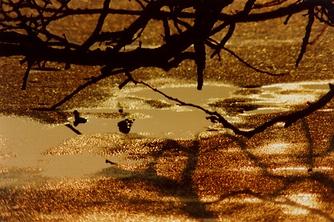
|
|
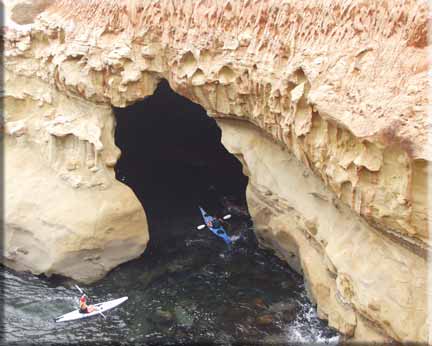
|
<<
Figure 5
Two canoes passing through
Sunny Jim Cave at the
seashore of La Jolla.
|
The
intent of this essay is by no mean to downplay philosophy, psychology,
and theology. Nor does it deny the merits of other art forms that
require deep analysis. Obviously, each art form has unique attributes.
In my opinion, photography is a visual art of common sense,
an art of mind, and an art of the
medium as the message.

